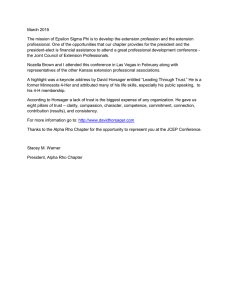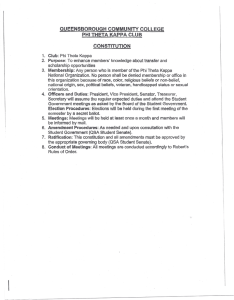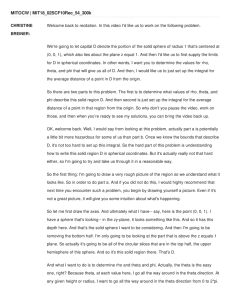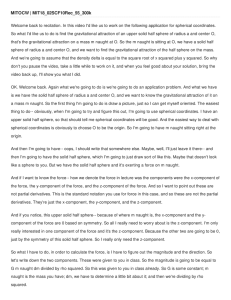Hints to Assignment #2 -- 8.022
advertisement
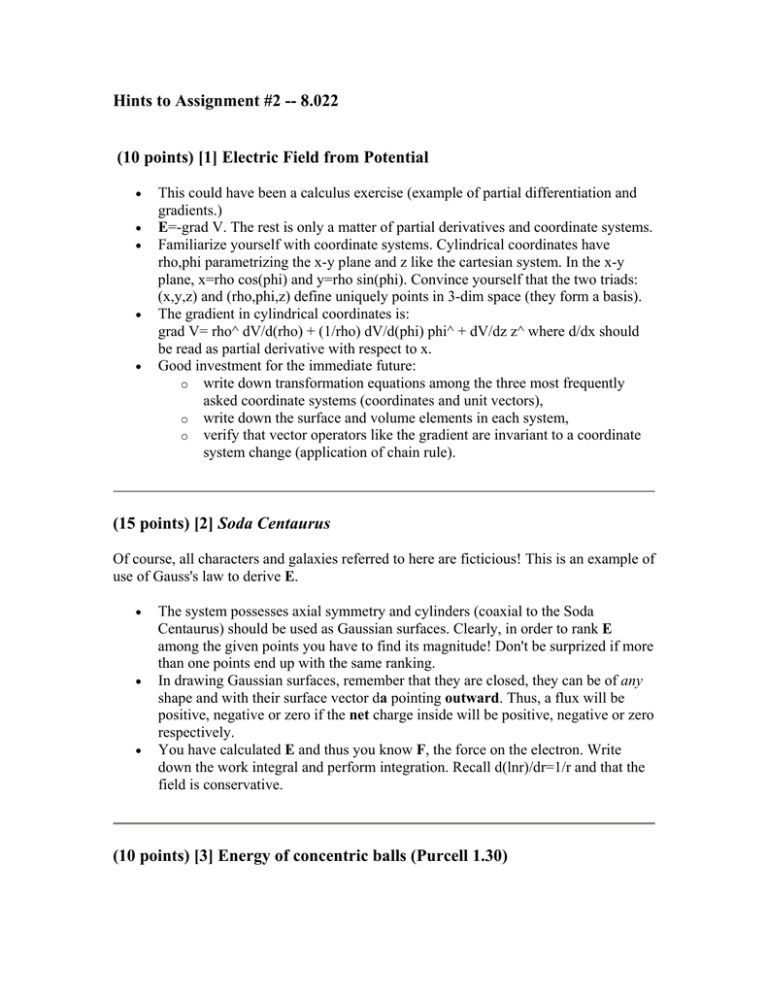
Hints to Assignment #2 -- 8.022 (10 points) [1] Electric Field from Potential This could have been a calculus exercise (example of partial differentiation and gradients.) • E=-grad V. The rest is only a matter of partial derivatives and coordinate systems. • Familiarize yourself with coordinate systems. Cylindrical coordinates have rho,phi parametrizing the x-y plane and z like the cartesian system. In the x-y plane, x=rho cos(phi) and y=rho sin(phi). Convince yourself that the two triads: (x,y,z) and (rho,phi,z) define uniquely points in 3-dim space (they form a basis). • The gradient in cylindrical coordinates is: grad V= rho^ dV/d(rho) + (1/rho) dV/d(phi) phi^ + dV/dz z^ where d/dx should be read as partial derivative with respect to x. • Good investment for the immediate future: o write down transformation equations among the three most frequently asked coordinate systems (coordinates and unit vectors), o write down the surface and volume elements in each system, o verify that vector operators like the gradient are invariant to a coordinate system change (application of chain rule). • (15 points) [2] Soda Centaurus Of course, all characters and galaxies referred to here are ficticious! This is an example of use of Gauss's law to derive E. The system possesses axial symmetry and cylinders (coaxial to the Soda Centaurus) should be used as Gaussian surfaces. Clearly, in order to rank E among the given points you have to find its magnitude! Don't be surprized if more than one points end up with the same ranking. • In drawing Gaussian surfaces, remember that they are closed, they can be of any shape and with their surface vector da pointing outward. Thus, a flux will be positive, negative or zero if the net charge inside will be positive, negative or zero respectively. • You have calculated E and thus you know F, the force on the electron. Write down the work integral and perform integration. Recall d(lnr)/dr=1/r and that the field is conservative. • (10 points) [3] Energy of concentric balls (Purcell 1.30) We have conjectured (today, prove tomorrow) that the electrostatic field energy density is dU/dv = u = E^2/(8*pi). Thus, in order to find the energy stored in the field you will have to integrate u over the entire space (well, actually over the part of space where E is non zero...). • Use Gaussian spheres and Gauss's law to find E in the three regions defined by the two cells and integrate. Use spherical coordinates [dv=r sin(theta) d(phi) r d(theta) dr -- did you make that investment??]. • OPTIONAL BUT IMPORTANT: Does this energy INCLUDE the SELF ENERGY of the spheres? Would you get the same answer on energy stored in the field if you calculate the WORK SPENT to place the charges on the two spheres? • (10 points) [4] Potential energy of a 1-dim crystal (Purcell 1.3) Another problem that could be a math problem (series expansion). • • • Draw a picture of the 1-dim lattice! Assume N ions are already in place and calculate the work needed to bring the N+1. This is the potential energy per ion. ln(1+x)=1 - x/2 + x^2/3 - x^3/4 .... AND CONVERGES for |x|<=1 (15 points) [5] Hollow sphere (Purcell 1.4) Beautiful example of coupling Mr. Gauss and Superposition. Envision the picture drawn as the superposition of two filled spheres, one of radius a and charge density pho and a second sphere of radius a/2 and charge density -pho placed appropriately so that the charge in the cavity adds up to zero. • Use Gauss law to find E field for each sphere and then add them vectorially. • OPTIONAL: convince yourself the field ANYWHERE inside the cavity is uniform (draw field lines). In addition this value is independent of the size of the cavity and only depends on the position of the cavity! • (10 points) [6] Charged cylinder (Purcell 2.8) • • We derived the fields E (both inside and outside) in class. Use the definition of potential to find it from E. • It's worth noticing that E is continuous on the cylinder, thus V has to be ?? (15 points) [7] Potential from continuous charge distribution (Purcell 2.10) • • • A good example of how superposition works for continuous charges. Write down the infinitesimal dV from the infinitesimal dq and integrate. A KEY issue in applying superposition of potentials is that ALL contributing elements (the dq's in this case) have the same behavior at infinity (or at a dialed reference point). Is this satisfied here? (15 points) [8] Electric Dipole Draw electric field lines showing E. Position dipole and some angle theta w/r/t E, identify F on it. What is the total F on the rod? • Use definition of torque (rxF) and derive it. • Assume dipole is initially placed perpendicular to the field lines and arbitrarily assign U=0 there. Find the work of the pair of forces as it is rotated to angle theta w/r/t E. Try to plot U(theta). • •
